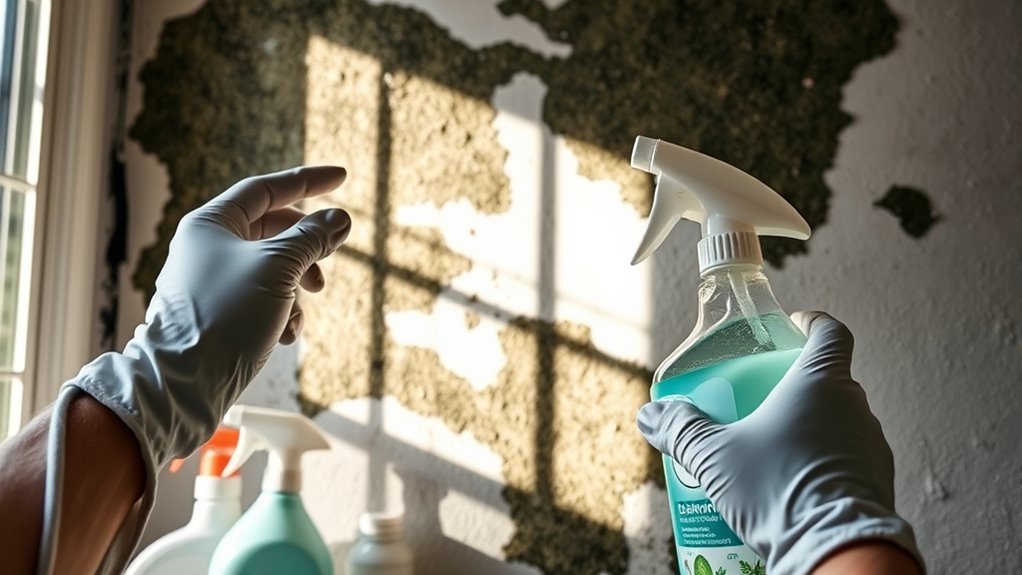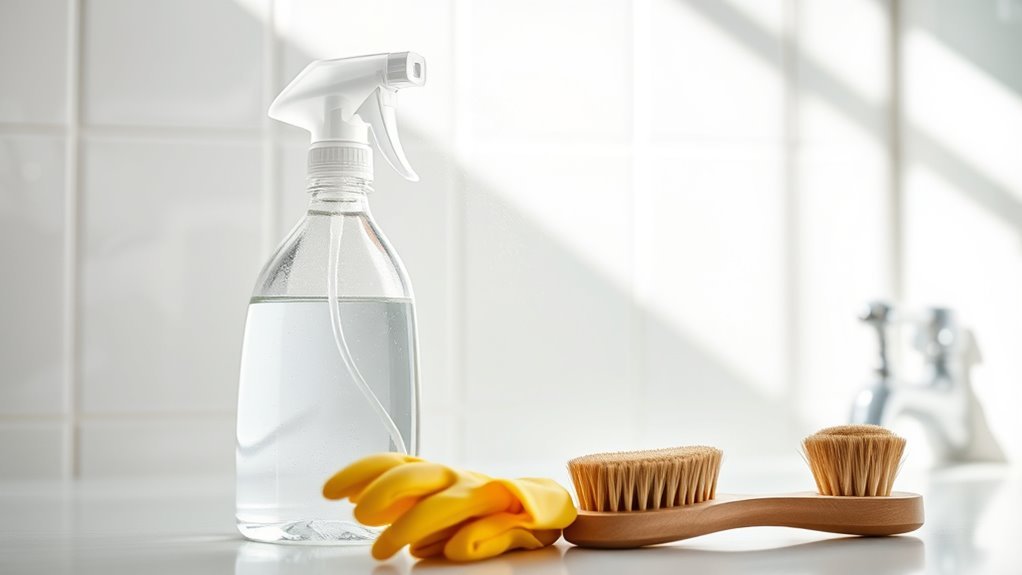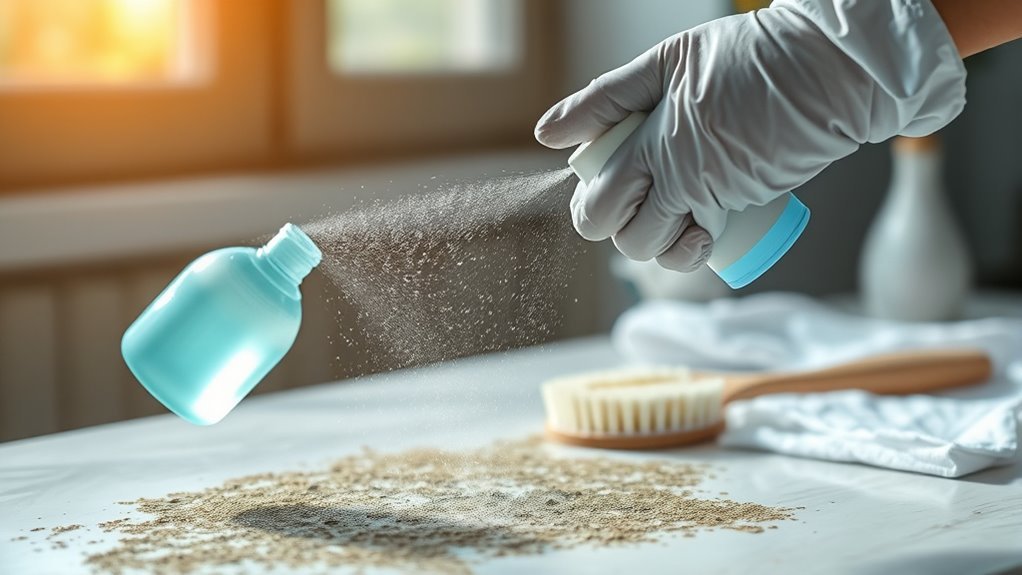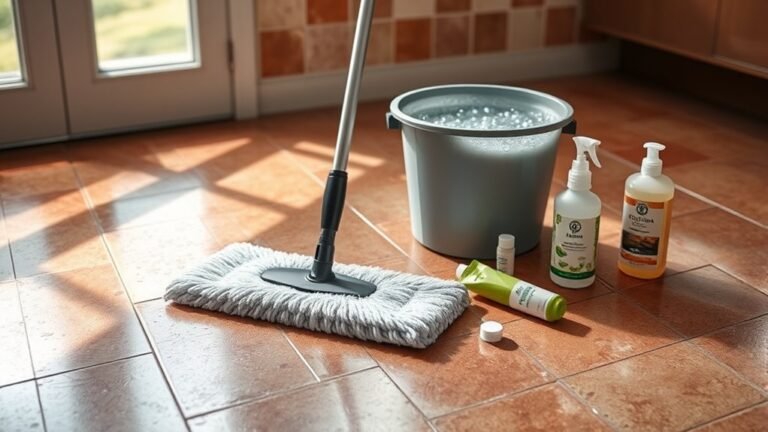Best Way to Sanitize Your Mold
To sanitize mold effectively, start by identifying the type of mold and wear protective gear like gloves and an N95 mask. Guarantee good ventilation, then clean the area with detergent or natural solutions like vinegar. Rinse and dry thoroughly to stop regrowth, and control moisture with dehumidifiers or good airflow. Always dispose of contaminated materials safely to avoid spreading spores. If you want to know how to prevent mold from coming back or when to get professional help, keep exploring the steps ahead.
Identifying Different Types of Mold

Mold comes in many varieties, and knowing how to identify them can help you choose the right way to sanitize. When you’re ready to take control of your space, understanding mold identification techniques empowers you to act confidently. Common mold types like black mold, aspergillus, and penicillium each have distinct appearances and growth habits. You’ll notice black mold often looks dark and slimy, while aspergillus can appear green or yellowish and penicillium might have a blue-green hue. By using simple visual inspection and, if needed, mold testing kits, you can pinpoint the mold type without relying on professionals. This knowledge sets you free from uncertainty, allowing you to tackle mold effectively and protect your home with the right cleaning approach.
Essential Safety Precautions Before Cleaning
Before you start cleaning, it’s important to protect yourself from potential health risks by wearing proper safety gear like gloves, masks, and goggles. Taking these precautions guarantees you maintain your freedom to breathe easy and avoid harmful mold exposure. Follow these important steps:
- Wear protective gear: Gloves, N95 masks, and goggles shield your skin, lungs, and eyes.
- Guarantee proper ventilation: Open windows and use fans to circulate fresh air and reduce airborne mold spores.
- Seal off the area: Use plastic sheeting to prevent spores spreading to other parts of your home.
- Turn off HVAC systems: Stop mold spores from circulating through vents.
Choosing the Right Cleaning Solutions

When tackling mold, you’ll need to pick between natural and chemical cleaners based on what’s safest and most effective for your space. Each type has its pros and cons, especially regarding health risks and cleaning power. Let’s explore how to make the best choice for your situation.
Natural Vs Chemical Cleaners
Although you might prefer natural cleaners for their eco-friendliness, chemical solutions often offer stronger, faster mold removal. When choosing between natural cleaners and chemical cleaners, consider what fits your lifestyle and values. Here’s how to weigh your options:
- Natural cleaners use ingredients like vinegar or baking soda, giving you a safer, less toxic option.
- Chemical cleaners contain powerful agents that kill mold quickly but may require precautions.
- Natural cleaners may take longer to work, so patience is key.
- Chemical cleaners often demand ventilation and protective gear to keep you safe.
Effectiveness and Safety Considerations
Since mold can pose health risks and damage your home, choosing a cleaning solution that’s both effective and safe is crucial. You want sanitization methods that not only eliminate mold but also protect your mold health by minimizing exposure to harsh chemicals. Natural cleaners like vinegar and baking soda offer a safer alternative, though they might require more effort to fully remove mold. Chemical solutions, while potent, often come with strong fumes and potential health hazards. Balancing effectiveness with safety means selecting products or methods that fit your personal comfort and environment. Always wear protective gear and guarantee proper ventilation during cleanup. By making informed choices, you protect your freedom to live in a mold-free space without compromising your well-being.
Step-by-Step Mold Removal Process
Before you plunge into mold removal, you’ll want to gather all necessary supplies and make sure the area is well-ventilated. Tackling mold growth requires focused cleaning techniques to guarantee you’re not just moving spores around. Here’s a straightforward approach:
- Wear protective gear—gloves, mask, and goggles—to keep yourself safe.
- Scrub affected surfaces with a detergent solution to remove visible mold.
- Rinse thoroughly and dry the area completely to prevent moisture buildup.
- Dispose of contaminated materials responsibly to avoid spreading mold spores.
Preventing Mold Regrowth in Your Home

To keep mold from coming back, you’ll need to control moisture and maintain good airflow in your home. Effective mold prevention strategies focus on humidity control and fixing leaks promptly. Ventilate damp areas like bathrooms and kitchens to let fresh air circulate freely. Dehumidifiers can help keep indoor humidity below 60%, making your space less inviting for mold.
| Challenge | Solution | Feeling Gained |
|---|---|---|
| Damp walls | Verwenden Sie einen Luftentfeuchter | Relief |
| Poor ventilation | Open windows, fans | Freshness |
| Hidden leaks | Regular inspections | Confidence |
| High humidity | Mold-resistant paint | Protection |
When to Call a Professional Mold Remediation Service
How do you know when mold is too much to handle on your own? Sometimes, it’s best to seek a professional assessment to guarantee your home stays safe and mold-free. Consider calling a mold remediation service if:
Knowing when to call a mold remediation expert ensures your home remains safe and mold-free.
- You spot mold covering more than 10 square feet.
- You experience persistent health issues linked to mold exposure.
- Mold keeps returning despite your cleaning efforts.
- You’re unsure about the extent of mold contamination and want a thorough mold inspection.
Don’t let mold limit your freedom at home. A professional team can quickly identify hidden mold and remove it safely, giving you peace of mind. When in doubt, trust experts to protect your space and your health, so you can enjoy your home without worry.
Häufig gestellte Fragen
Can Mold Cause Allergic Reactions in Pets?
Yes, mold can definitely cause allergic reactions in your pets, affecting their pet health. You might notice sneezing, itching, or even respiratory issues. It’s important you keep their environment mold-free to help them breathe easy and stay comfortable. Since your pets rely on you for their wellbeing, being proactive about mold can prevent those pesky allergic reactions and keep their freedom to enjoy a healthy, happy life without unnecessary discomfort.
How Does Humidity Affect Mold Growth?
Humidity levels play a huge role in mold growth—you’ll find mold thrives in damp, humid environments. If you want to keep your space mold-free and enjoy the freedom of a healthy home, controlling humidity is key. Aim to keep humidity levels below 60%, ideally between 30-50%. Using dehumidifiers, proper ventilation, and fixing leaks helps with mold prevention, so you don’t feel trapped by unwanted mold issues.
Are There Natural Alternatives to Chemical Mold Cleaners?
Like discovering a hidden treasure, you can embrace natural alternatives to chemical mold cleaners. A vinegar solution, known for its antifungal powers, can be your first line of defense. Tea tree oil, a potent natural antifungal, works wonders too—just mix a few drops with water and spray. These options let you take control, cleaning mold while keeping your space chemical-free and your freedom intact.
Does Mold Impact Indoor Air Quality Significantly?
Yes, mold exposure can greatly impact indoor air quality by releasing spores and mycotoxins, which become indoor pollutants. When you breathe in these contaminants, it can lead to health issues like allergies or respiratory problems. You want your home to feel like a safe haven, free from harmful pollutants that restrict your freedom to breathe easy. Managing mold helps you reclaim that clean, fresh indoor air you deserve.
Can Mold Grow on Non-Porous Surfaces Like Glass?
It’s funny you ask about mold on glass—since glass is non-porous, you’d think it’s immune, right? But mold can still grow there if moisture and dirt linger. To keep your freedom intact from unwanted spores, use effective glass cleaning methods like vinegar or alcohol solutions. Remember, mold prevention techniques focus on keeping surfaces dry and clean, so you won’t feel trapped by mold’s grip on your living space.






